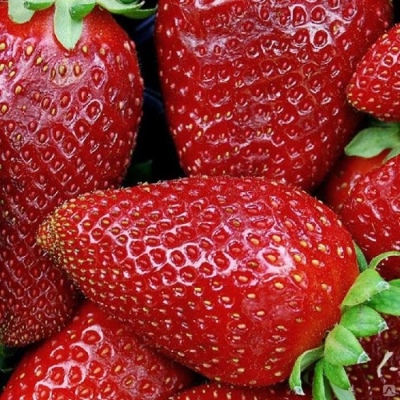
- Authors: Holland
- Taste: sweet
- The size: medium and large
- Weight: 35-40 gr
- Yield rate: high
- Yield: 0.75-1 kg per bush
- Repairability: Yes
- Advantages: decorative bush
- disadvantages: low density of berries
- Appointment: universal
If you want strawberry bushes not only to please with juicy berries, but also to decorate the garden, then our hero is what you might like. Florian F1 is a relatively new hybrid variety of garden strawberries that came to us from Holland, but already has loyal fans in the CIS. Why they love him, what nuances need to be taken into account when choosing him, we will tell below.
Description of the variety
Florian is a variety of garden strawberries, related to plants of neutral daylight hours. The variety has compact, medium-sized, reaching a maximum of 30 cm in height, 35 cm in diameter bushes with powerful peduncles, large light green leaves.
Up to 10 peduncles are formed on each bush. The flowers are pink with 5 rounded petals.
One of the main advantages of the variety is decorativeness. Florian bushes are not only a source of delicious strawberries, but also a decoration of the garden area. The variety is also suitable for growing in pots.
Ripening terms
It is a remontant variety with a long flowering period and early fruiting. Florian blooms from May to October almost continuously, can give up to 4 harvest waves per season.
Yield
On a properly selected soil, it has a high degree of productivity, 0.75–1 kg of berries can be harvested from a bush, and in a particularly successful season, 1.8 kg of berries.
Berries and their taste
Strawberries have a slightly elongated, wide-conical shape. They are light red, weighing from 20 to 35-40 g. Small berries are rare, mostly medium or large.
The fruits are sweet, with a slight sour aftertaste, delicate pulp and pronounced aroma. By design, the berries are universal: they are equally well suited for fresh consumption, for canning, and for freezing. Unfortunately, according to most gardeners, Florian has a low density of berries, which leads to poor transportability. However, not everyone agrees with this.
Growing features
Seedlings are planted in the ground after the formation of 6 true leaves. The recommended distance between rows is 25-30 cm, between plants - at least 15 cm, and better - 20 or more.
Strawberries are sown for seedlings in late winter - early spring. The soil mixture for planting is prepared from 3 parts of sand and 5 parts of loose humus, and then warmed up in the oven. Seeds are placed shallow, almost on the soil surface.
Gardeners advise, after planting, to remove the container with seeds covered with foil for a couple of days in the refrigerator, and after that put it in a place with a temperature of about 20 ° C for germination. When 1-2 true leaves appear, the seedlings should be transplanted from the common box into pots and kept at a temperature of about 15 ° C.
When watering plants already planted in the ground, you need to focus on the condition of the soil. Watering is recommended with warm water.




Site selection and soil preparation
The variety is quite picky about the soil. Heavy, wet soil will not work for him. We need a light, humus-rich land. Good moisture and air permeability is required. The acidity level should be in the range of 5.5-6 pH. When planting on black earth, the soil must first be properly loosened.
It is better to plant strawberries in a sunny place. If the beds are located in the lowlands, they should be raised by at least 15–20 cm.

Pollination
With regard to pollination, the main thing is not to forget to remove the covering material from the plant during the flowering period in order to give insects access to flowers.
Top dressing
You can fertilize with mineral fertilizers. Fertilizers should be applied in 2 stages: in spring and after harvest. When planting in sandy soil, it is better to pre-fertilize the place with compost or manure according to the scheme 4–5 kg / m 2.

One of the important techniques in strawberry care is feeding. Regular fertilization guarantees a rich harvest. There are several different ways to feed strawberries, and each of them is designed for a specific period of plant development. During flowering, fruiting and after it, feeding should be different.
Frost resistance and the need for shelter
The hybrid is drought tolerant, but wintering needs to be taken care of. The best option is to cover the strawberries for the winter with white agrotextile P-23 or even P-50. You need to cover in late autumn or early winter.

Diseases and pests
The variety is resistant to gray rot and most diseases typical of garden strawberries.

Strawberries are often subject to many dangerous diseases that can seriously undermine its condition. Among the most common are powdery mildew, gray mold, brown spot, anthracnose, and verticillosis. Before buying a variety, you need to inquire about its disease resistance.
Reproduction
The peculiarity of the variety is its mustache. They are, but Florian's ability to form them is weak.This is not an unfortunate misunderstanding, but the original idea of the Dutch breeders. This is done to simplify the care of the plant and to preserve the decorative qualities. The average number of whiskers formed by one adult bush per year is up to 40. Florian can be grown both from seedlings and seeds.

Review overview
Gardeners who have already dealt with this hybrid note the good germination of seeds, the delicate aroma of strawberry flowers, and active fruiting. The taste of berries also raises no questions: it is characterized as delicate, somewhat similar to the taste of a peach.
The main complaint about the variety is the small number of mustaches. It is also noted that the flowers do not always acquire a rich pink hue - for many they remain pale pink.


















































































